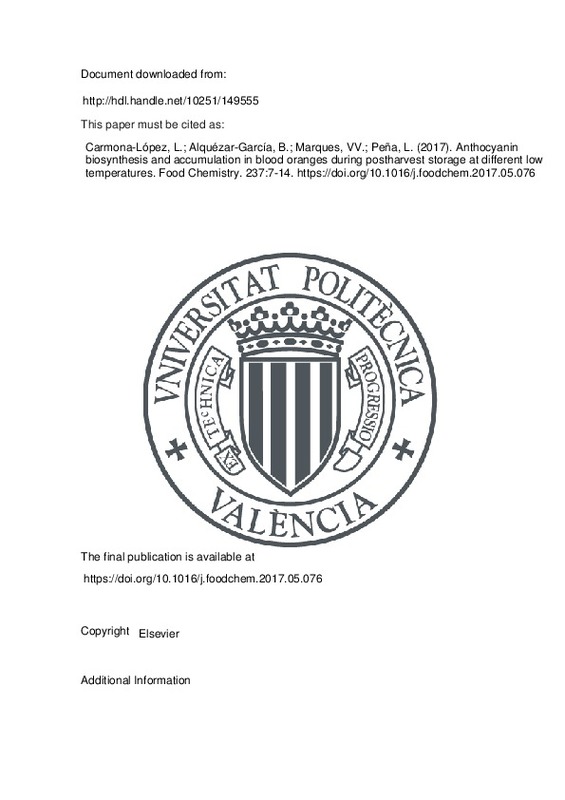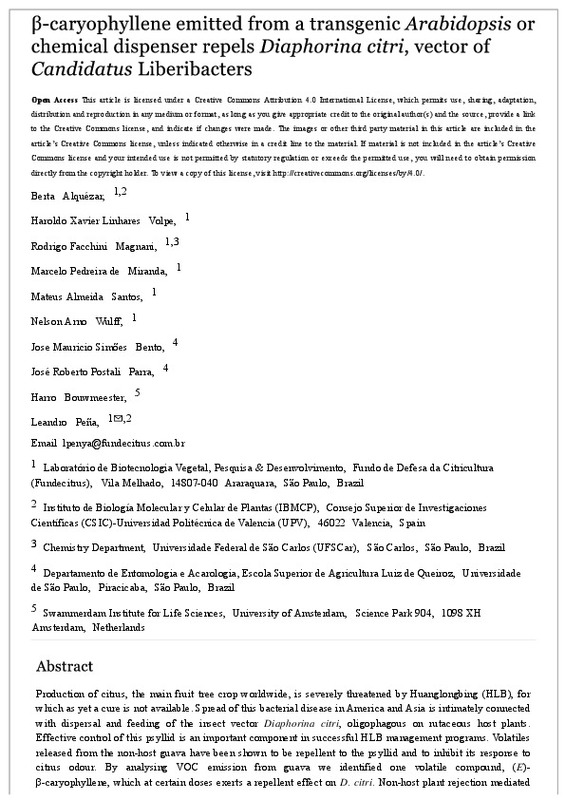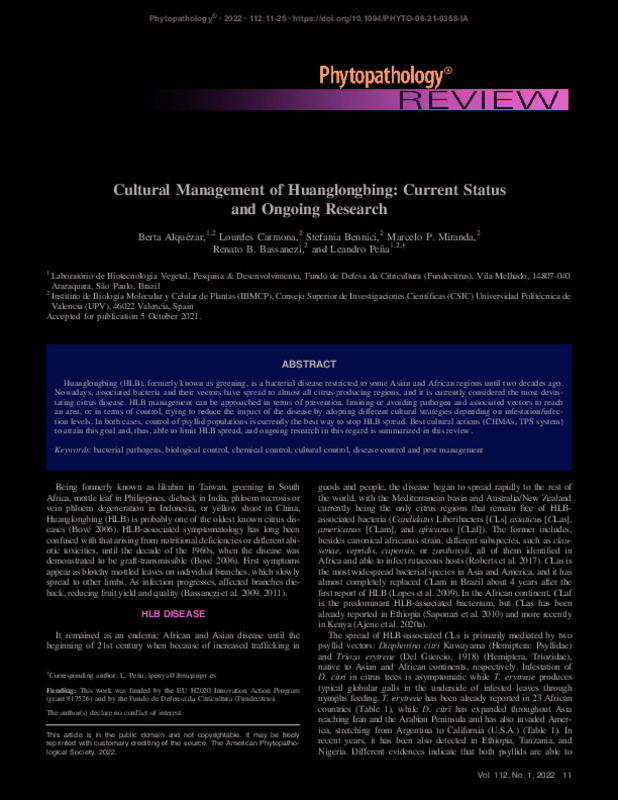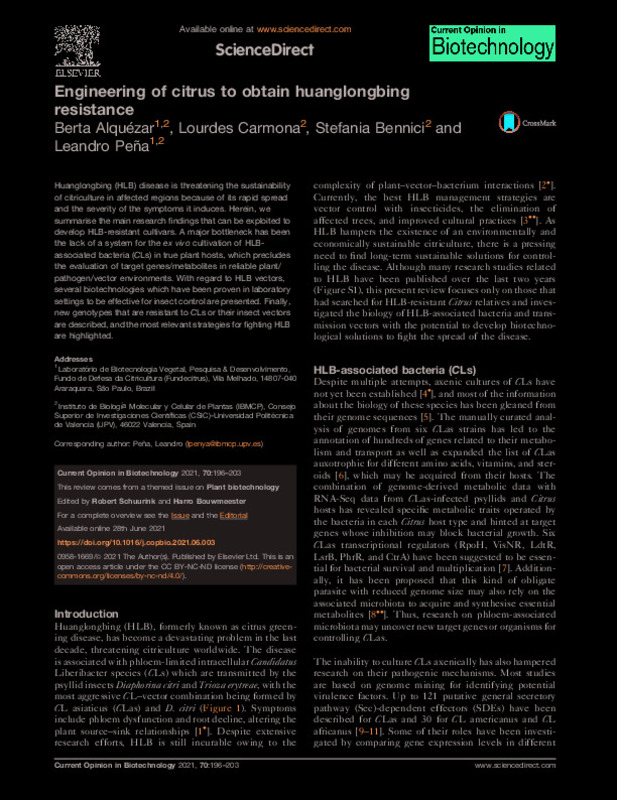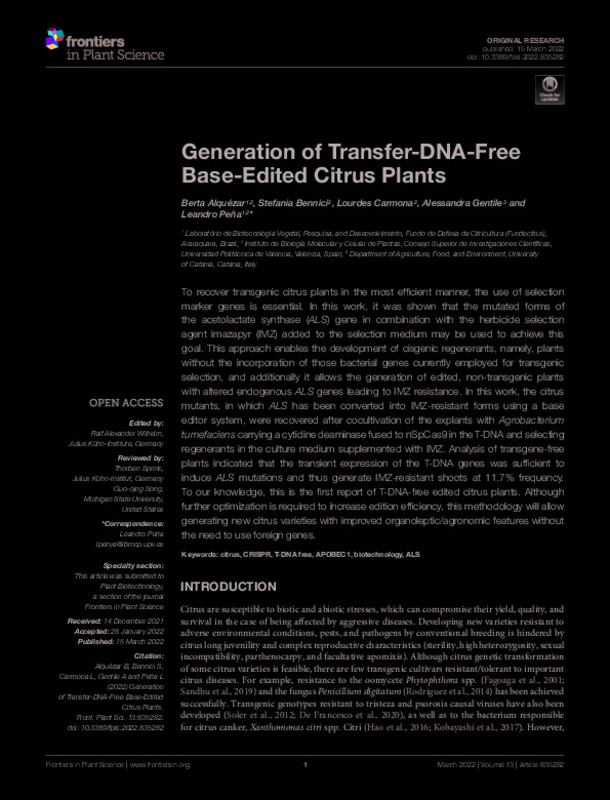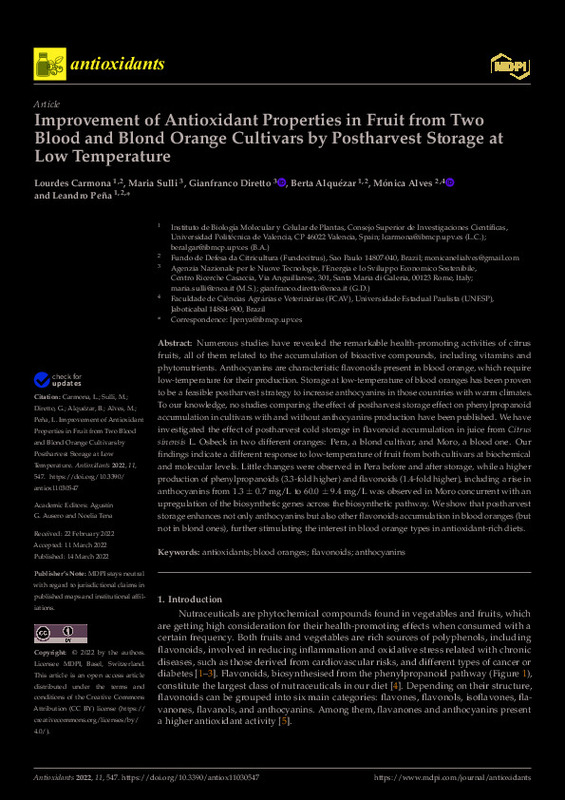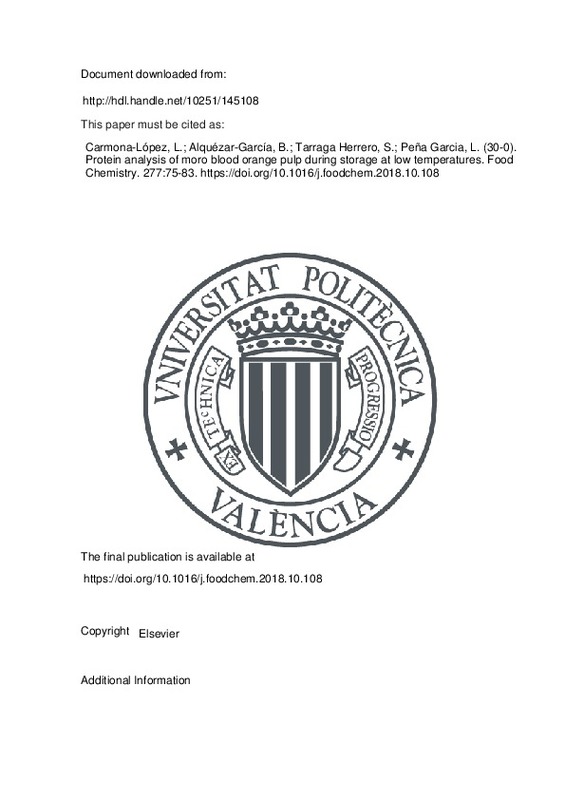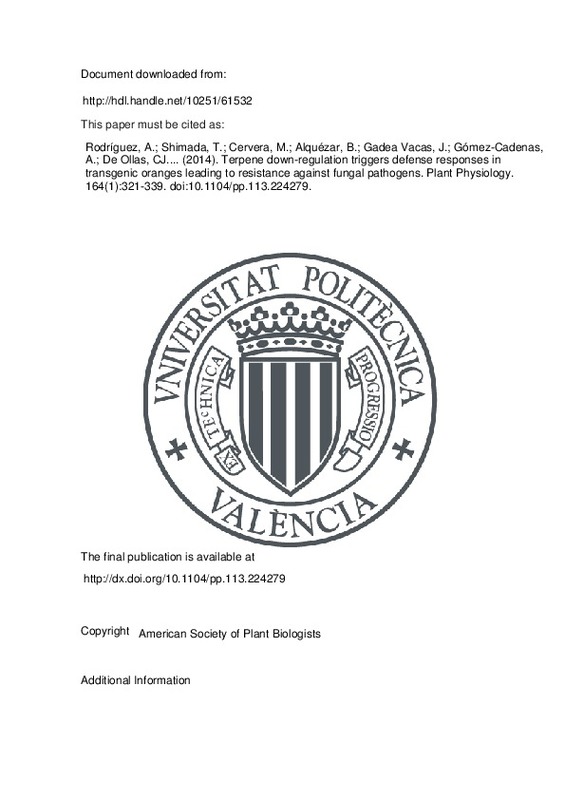

Listar por autor "Alquézar García, Berta"
RiuNet: Repositorio Institucional de la Universidad Politécnica de Valencia
- RiuNet repositorio UPV
- :
- Listar por autor
JavaScript is disabled for your browser. Some features of this site may not work without it.
Buscar en RiuNet
Listar
Mi cuenta
Ayuda RiuNet
Admin. UPV
Listar por autor "Alquézar García, Berta"
Mostrando ítems 1-16 de 16
-
Carmona-López, Lourdes; Alquézar-García, Berta; Marques, Viviani V.; Peña, L. (Elsevier, 2017-12-15)[EN] Blood oranges require low temperature for anthocyanin production. We have investigated the activation of anthocyanin biosynthesis and accumulation in the pulp of Moro blood and Pera blond oranges (Citrus sinensis L. ...
-
Alquézar-García, Berta; Linhares Volpe, Haroldo Xavier; Magnani, Rodrigo Facchini; de Miranda, Marcelo Pedreira; Santos, Mateus Almeida; Wulff, Nelson Arno; Simoes Bento, Jose Mauricio; Postali Parra, Jose Roberto; Bouwmeester, Harro; Peña, Leandro (Nature Publishing Group, 2017)[EN] Production of citrus, the main fruit tree crop worldwide, is severely threatened by Huanglongbing (HLB), for which as yet a cure is not available. Spread of this bacterial disease in America and Asia is intimately ...
-
Carmona-López, Lourdes; Alquézar-García, Berta; PEÑA GARCIA, LEANDRO (MDPI, 2024-08)[EN] Carotenoid-rich foods such as citrus fruits have a wide range of functions in human health. They primarily exert antioxidant effects, but individual carotenoids may also act through other health-promoting mechanisms ...
-
Alquézar-García, Berta; Carmona, Lourdes; Bennici, Stefania; Miranda, Marcelo P.; Bassanezi, Renato B.; Peña, Leandro (Scientific Societies, 2022-01)[EN] Huanglongbing (HLB), formerly known as greening, is a bacterial disease restricted to some Asian and African regions until two decades ago. Nowadays, associated bacteria and their vectors have spread to almost all ...
-
Carmona, Lourdes; Alquézar-García, Berta; Diretto, Gianfranco; Sevi, Filippo; Malara, Tatiane; Lafuente, M. Teresa; PEÑA GARCIA, LEANDRO (Elsevier, 2021-04-16)[EN] Anthocyanins are pigments present in blood oranges which can be enriched by post-harvest cold storage. Additionally, citrus fruits contain appreciable levels of other flavonoids, whose content increases under postharvest ...
-
Carmona-López, Lourdes; Alquézar-García, Berta; Tarraga Herrero, Susana; PEÑA GARCIA, LEANDRO (International Society for Horticultural Science (ISHS), 2019-01)[EN] Anthocyanins are a subclass of flavonoid pigments with important therapeutic properties beneficial to human health. Blood oranges are rich in these pigments, which present synergistic effects (i.e., anti-inflammatory ...
-
Alquézar-García, Berta; Linhares Volpe, Haroldo Xavier; Facchini Magnani, Rodrigo; Pedreira de Miranda, Marcelo; Almeida Santos, Mateus; Vieira Marques, Viviani; Rodrigues de Almeida, Márcia; Arno Wulff, Nelson; Ting, Hieng-Ming; de Vries, Michel; Schuurink, Robert; Bouwmeester, Harro; Peña, Leandro (Frontiers Media SA, 2021-03-02)[EN] Huanglongbing (HLB) is a destructive disease, associated with psyllid-transmitted phloem-restricted pathogenic bacteria, which is seriously endangering citriculture worldwide. It affects all citrus species and cultivars ...
-
Alquézar-García, Berta; Carmona, Lourdes; Bennici, Stefania; Peña, Leandro (Elsevier, 2021-08)[EN] Huanglongbing (HLB) disease is threatening the sustainability of citriculture in affected regions because of its rapid spread and the severity of the symptoms it induces. Herein, we summarise the main research findings ...
-
Alquézar-García, Berta; Bennici, Stefania; Carmona, Lourdes; Gentile, Alessandra; Peña, Leandro (Frontiers Media SA, 2022-03-15)[EN] To recover transgenic citrus plants in the most efficient manner, the use of selection marker genes is essential. In this work, it was shown that the mutated forms of the acetolactate synthase (ALS) gene in combination ...
-
Carmona, Lourdes; Sulli, Maria; Diretto, Gianfranco; Alquézar-García, Berta; Alves, Mónica; Peña, Leandro (MDPI, 2022-03)[EN] Numerous studies have revealed the remarkable health-promoting activities of citrus fruits, all of them related to the accumulation of bioactive compounds, including vitamins and phytonutrients. Anthocyanins are ...
-
Tomaseto, Arthur F.; Marques, Rodrigo N.; Fereres, Alberto; Zanardi, Odimar Z.; Volpe, Haroldo X. L.; Alquézar-García, Berta; Peña, Leandro; Miranda, Marcelo P. (Nature Publishing Group, 2019-02-14)[EN] Novel, suitable and sustainable alternative control tactics that have the potential to reduce migration of Diaphorina citri into commercial citrus orchards are essential to improve management of huanglongbing (HLB). ...
-
Carmona-López, Lourdes; Alquézar-García, Berta; Tarraga Herrero, Susana; PEÑA GARCIA, LEANDRO (Elsevier, 2019-03-30)[EN] A protein analysis in the pulp of Moro blood oranges (Citrus sinensis L. Osbeck) at the onset and after 30 days of storage at either 4 or 9 degrees C was performed. All differential proteins belonged to different ...
-
Eduardo, Wellington Ivo; Miranda, Marcelo Pedreira; Linhares Volpe, Haroldo Xavier; Garcia, Rafael Brandao; Alquézar-García, Berta; Girardi, Eduardo Augusto; Espinosa Ruiz, Ana; Peña, Leandro (John Wiley & Sons, 2022-11)[EN] BACKGROUND Host genetic resistance is a promising strategy for the management of Diaphorina citri Kuwayama (Hemiptera: Psyllidae), and consequently Huanglongbing (HLB). To date, no study has investigated the resistance ...
-
Rodriguez, Ana; San Andrés Aura, Victoria; Cervera, Magdalena; Redondo, Ana; ALQUÉZAR, B; Shimada, Takehiko; Gadea Vacas, José; Rodrigo, Maria Jesús; ZACARIAS, Lorenzo; Palou, Lluis; Lopez, María M.; Catañera, Pedro; PEÑA GARCIA, LEANDRO (American Society of Plant Biologists, 2011-06)[EN] Plants use volatile terpene compounds as odor cues for communicating with the environment. Fleshy fruits are particularly rich in volatiles that deter herbivores and attract seed dispersal agents. We have investigated ...
-
Rodríguez, Ana; Shimada, Takehiko; Cervera, Magdalena; Alquézar, Berta; Gadea Vacas, José; Gómez-Cadenas, Aurelio; De Ollas, Carlos José; Rodrigo, María Jesús; Zacarías, Lorenzo; PEÑA GARCIA, LEANDRO (American Society of Plant Biologists, 2014-01)Terpenoid volatiles are isoprene compounds that are emitted by plants to communicate with the environment. In addition to their function in repelling herbivores and attracting carnivorous predators in green tissues, the ...
-
Rodríguez, Ana; San Andrés Aura, Victoria; Cervera, Magdalena; Redondo, Ana; Alquézar, Berta; Shimada, Takehiko; Gadea Vacas, José; Rodrigo, María; ZACARIAS, Leandro; Palou, Lluis; Lopez, María M.; Castañera, Pedro; PEÑA GARCIA, LEANDRO (Taylor & Francis, 2011-11-01)[EN] Plant volatiles include terpenoids, which are generally involved in plant defense, repelling pests and pathogens and attracting insects for herbivore control, pollination and seed dispersal. Orange fruits accumulate ...
Mostrando ítems 1-16 de 16

Universitat Politècnica de València. Unidad de Documentación Científica de la Biblioteca (+34) 96 387 70 85 · RiuNet@bib.upv.es


